#Near-Infrared Camera (NIRCam)
Explore tagged Tumblr posts
Text
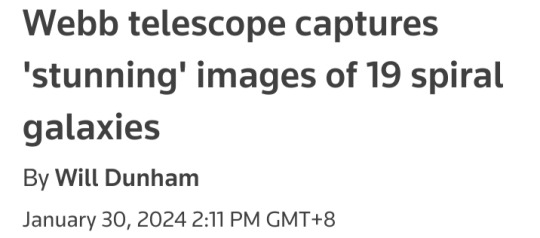
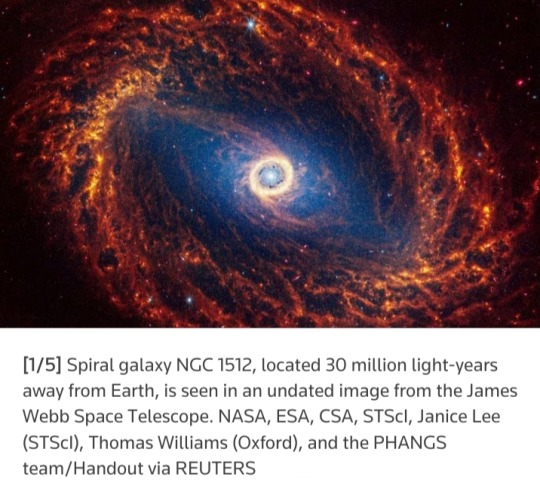
WASHINGTON, Jan 29 (Reuters) — A batch of newly released images captured by the James Webb Space Telescope show in remarkable detail 19 spiral galaxies residing relatively near our Milky Way, offering new clues on star formation as well as galactic structure and evolution.
The images were made public on Monday by a team of scientists involved in a project called Physics at High Angular resolution in Nearby GalaxieS (PHANGS) that operates across several major astronomical observatories.
The closest of the 19 galaxies is called NGC5068, about 15 million light years from Earth, and the most distant of them is NGC1365, about 60 million light years from Earth.
A light year is the distance light travels in a year, 5.9 trillion miles (9.5 trillion km).
The James Webb Space Telescope (JWST) was launched in 2021 and began collecting data in 2022, reshaping the understanding of the early universe while taking wondrous pictures of the cosmos.
The orbiting observatory looks at the universe mainly in the infrared.
The Hubble Space Telescope, launched in 1990 and still operational, has examined it primarily at optical and ultraviolet wavelengths.
Spiral galaxies, resembling enormous pinwheels, are a common galaxy type. Our Milky Way is one.
The new observations came from Webb's Near-Infrared Camera (NIRCam) and Mid-Infrared Instrument (MIRI).
They show roughly 100,000 star clusters and millions or perhaps billions of individual stars.
"These data are important as they give us a new view on the earliest phase of star formation," said University of Oxford astronomer Thomas Williams, who led the team's data processing on the images.
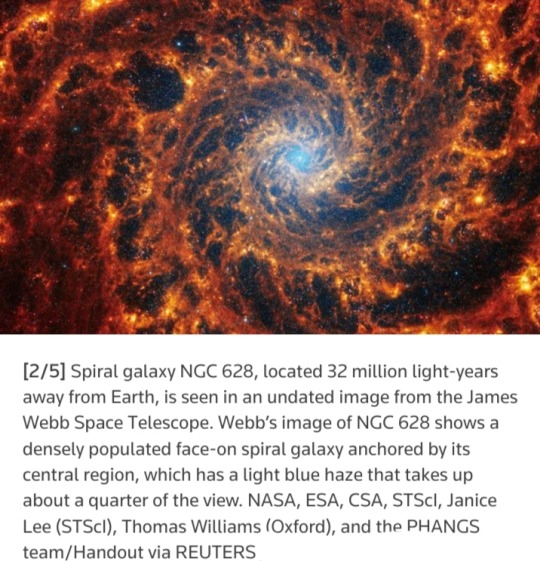
"Stars are born deep within dusty clouds that completely block out the light at visible wavelengths - what the Hubble Space Telescope is sensitive to - but these clouds light up at the JWST wavelengths.
We don't know a lot about this phase, not even really how long it lasts, and so these data will be vital for understanding how stars in galaxies start their lives," Williams added.
About half of spiral galaxies have a straight structure, called a bar, coming out from the galactic center to which the spiral arms are attached.
"The commonly held thought is that galaxies form from the inside-out, and so get bigger and bigger over their lifetimes.
The spiral arms act to sweep up the gas that will form into stars, and the bars act to funnel that same gas in towards the central black hole of the galaxy," Williams said.
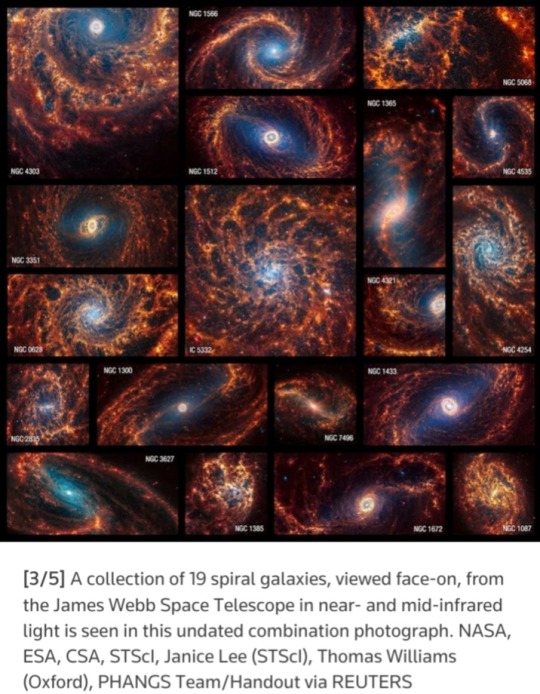
The images let scientists for the first time resolve the structure of the clouds of dust and gas from which stars and planets form at a high level of detail in galaxies beyond the Large Magellanic Cloud and Small Magellanic Cloud, two galaxies considered galactic satellites of the sprawling Milky Way.
"The images are not only aesthetically stunning, they also tell a story about the cycle of star formation and feedback, which is the energy and momentum released by young stars into the space between stars," said astronomer Janice Lee of the Space Telescope Science Institute in Baltimore, principal investigator for the new data.
"It actually looks like there was explosive activity and clearing of the dust and gas on both cluster and kiloparsec (roughly 3,000 light years) scales.
The dynamic process of the overall star formation cycle becomes obvious and qualitatively accessible, even for the public, which makes the images compelling on many different levels," Lee added.
Webb's observations build on Hubble's.
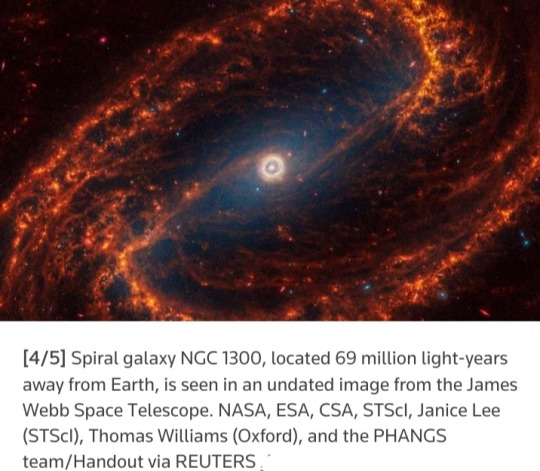
"Using Hubble, we would see the starlight from galaxies, but some of the light was blocked by the dust of galaxies," University of Alberta astronomer Erik Rosolowsky said.
"This limitation made it hard to understand parts of how a galaxy operates as a system. With Webb's view in the infrared, we can see through this dust to see stars behind and within the enshrouding dust."
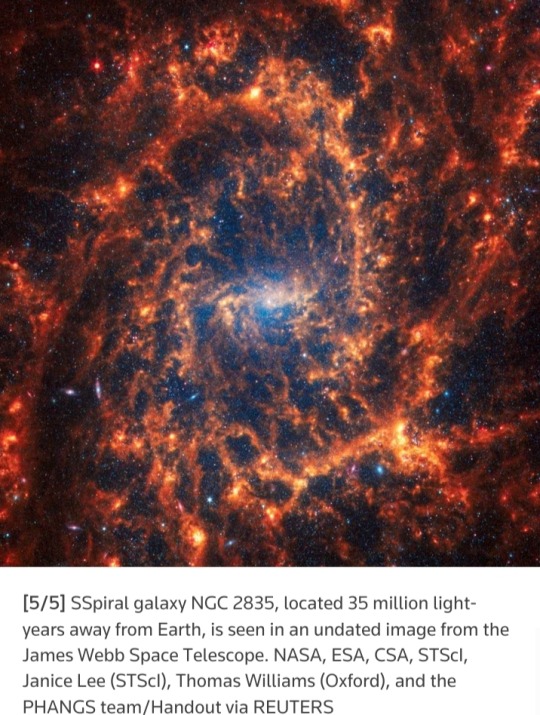
#James Webb Space Telescope#spiral galaxies#Milky Way#Physics at High Angular resolution in Nearby GalaxieS (PHANGS)#NGC5068#NGC1365#light year#Hubble Space Telescope#Near-Infrared Camera (NIRCam)#Mid-Infrared Instrument (MIRI)#astronomy#space#universe#cosmos#Large Magellanic Cloud#Small Magellanic Cloud#Space Telescope Science Institute
37 notes
·
View notes
Text
James Webb Space Telescope captures stunning images of actively forming stars
James Webb Space Telescope captures stunning images of actively forming stars
James Webb Space Telescope captures stunning images of actively forming stars. The James Webb Space Telescope has captured a stunning new image of two actively forming stars, collectively known as Herbig-Haro 46/47. The image shows the stars embedded in a disc of gas and dust, about 1,400 light-years away from Earth. James Webb Space Telescope has just captured a new image of actively forming…
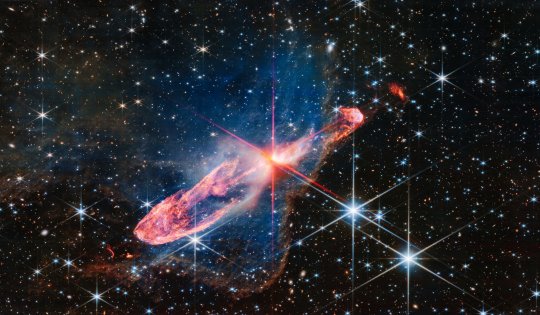
View On WordPress
#000 years old#1#100#400 light-years away#accreting#amazing images#bow shock#Herbig-Haro 46/47#Herbig-Haro object#James Webb Space Telescope#natal cocoon#Near-Infrared Camera (NIRCam)#power of JWST#revolutionize our understanding of star formation#star formation#stunning image
1 note
·
View note
Text
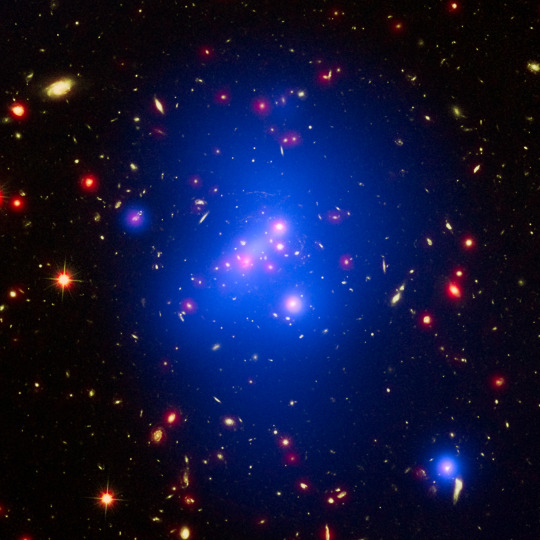
Astronomers used three of NASA's Great Observatories to capture this multiwavelength image showing galaxy cluster IDCS J1426.5+3508. It includes X-rays recorded by the Chandra X-ray Observatory in blue, visible light observed by the Hubble Space Telescope in green, and infrared light from the Spitzer Space Telescope in red. This rare galaxy cluster has important implications for understanding how these megastructures formed and evolved early in the universe.
How Astronomers Time Travel
Let’s add another item to your travel bucket list: the early universe! You don’t need the type of time machine you see in sci-fi movies, and you don’t have to worry about getting trapped in the past. You don’t even need to leave the comfort of your home! All you need is a powerful space-based telescope.
But let’s start small and work our way up to the farthest reaches of space. We’ll explain how it all works along the way.
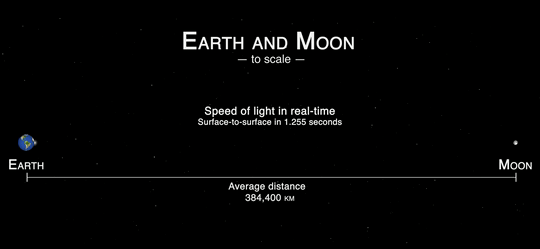
This animation illustrates how fast light travels between Earth and the Moon. The farther light has to travel, the more noticeable its speed limit becomes.
The speed of light is superfast, but it isn’t infinite. It travels at about 186,000 miles (300 million meters) per second. That means that it takes time for the light from any object to reach our eyes. The farther it is, the more time it takes.
You can see nearby things basically in real time because the light travel time isn’t long enough to make a difference. Even if an object is 100 miles (161 kilometers) away, it takes just 0.0005 seconds for light to travel that far. But on astronomical scales, the effects become noticeable.
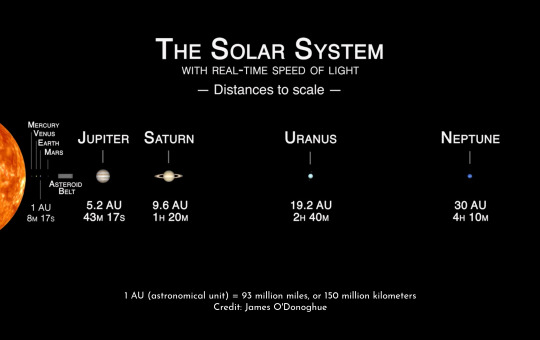
This infographic shows how long it takes light to travel to different planets in our solar system.
Within our solar system, light’s speed limit means it can take a while to communicate back and forth between spacecraft and ground stations on Earth. We see the Moon, Sun, and planets as they were slightly in the past, but it's not usually far enough back to be scientifically interesting.
As we peer farther out into our galaxy, we use light-years to talk about distances. Smaller units like miles or kilometers would be too overwhelming and we’d lose a sense of their meaning. One light-year – the distance light travels in a year – is nearly 6 trillion miles (9.5 trillion kilometers). And that’s just a tiny baby step into the cosmos.
youtube
The Sun’s closest neighboring star, Proxima Centauri, is 4.2 light-years away. That means we see it as it was about four years ago. Betelgeuse, a more distant (and more volatile) stellar neighbor, is around 700 light-years away. Because of light’s lag time, astronomers don’t know for sure whether this supergiant star is still there! It may have already blasted itself apart in a supernova explosion – but it probably has another 10,000 years or more to go.
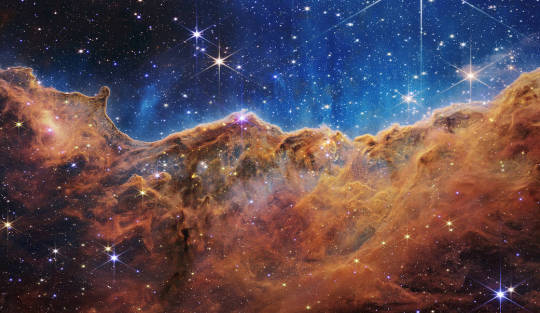
What looks much like craggy mountains on a moonlit evening is actually the edge of a nearby, young, star-forming region NGC 3324 in the Carina Nebula. Captured in infrared light by the Near-Infrared Camera (NIRCam) on NASA’s James Webb Space Telescope, this image reveals previously obscured areas of star birth.
The Carina Nebula clocks in at 7,500 light-years away, which means the light we receive from it today began its journey about 3,000 years before the pyramids of Giza in Egypt were built! Many new stars there have undoubtedly been born by now, but their light may not reach Earth for thousands of years.
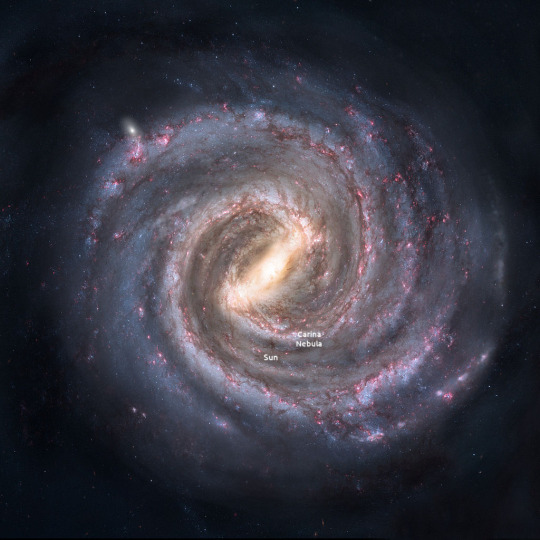
An artist’s concept of our Milky Way galaxy, with rough locations for the Sun and Carina nebula marked.
If we zoom way out, you can see that 7,500 light-years away is still pretty much within our neighborhood. Let’s look further back in time…
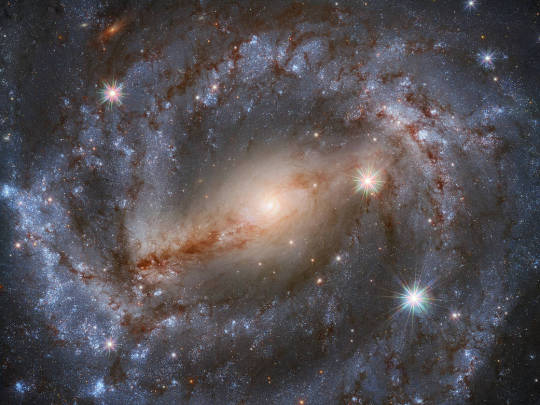
This stunning image by the NASA/ESA Hubble Space Telescope features the spiral galaxy NGC 5643. Looking this good isn’t easy; 30 different exposures, for a total of nine hours of observation time, together with Hubble’s high resolution and clarity, were needed to produce an image of such exquisite detail and beauty.
Peering outside our Milky Way galaxy transports us much further into the past. The Andromeda galaxy, our nearest large galactic neighbor, is about 2.5 million light-years away. And that’s still pretty close, as far as the universe goes. The image above shows the spiral galaxy NGC 5643, which is about 60 million light-years away! That means we see it as it was about 60 million years ago.
As telescopes look deeper into the universe, they capture snapshots in time from different cosmic eras. Astronomers can stitch those snapshots together to unravel things like galaxy evolution. The closest ones are more mature; we see them nearly as they truly are in the present day because their light doesn’t have to travel as far to reach us. We can’t rewind those galaxies (or our own), but we can get clues about how they likely developed. Looking at galaxies that are farther and farther away means seeing these star cities in ever earlier stages of development.
youtube
The farthest galaxies we can see are both old and young. They’re billions of years old now, and the light we receive from them is ancient since it took so long to traverse the cosmos. But since their light was emitted when the galaxies were young, it gives us a view of their infancy.

This animation is an artist’s concept of the big bang, with representations of the early universe and its expansion.
Comparing how fast objects at different distances are moving away opened up the biggest mystery in modern astronomy: cosmic acceleration. The universe was already expanding as a result of the big bang, but astronomers expected it to slow down over time. Instead, it’s speeding up!
The universe’s expansion makes it tricky to talk about the distances of the farthest objects. We often use lookback time, which is the amount of time it took for an object’s light to reach us. That’s simpler than using a literal distance, because an object that was 10 billion light-years away when it emitted the light we received from it would actually be more than 16 billion light-years away right now, due to the expansion of space. We can even see objects that are presently over 30 billion light-years from Earth, even though the universe is only about 14 billion years old.

This James Webb Space Telescope image shines with the light from galaxies that are more than 13.4 billion years old, dating back to less than 400 million years after the big bang.
Our James Webb Space Telescope has helped us time travel back more than 13.4 billion years, to when the universe was less than 400 million years old. When our Nancy Grace Roman Space Telescope launches in a few years, astronomers will pair its vast view of space with Webb’s zooming capabilities to study the early universe in better ways than ever before. And don’t worry – these telescopes will make plenty of pit stops along the way at other exciting cosmic destinations across space and time.
Learn more about the exciting science Roman will investigate on X and Facebook.
Make sure to follow us on Tumblr for your regular dose of space!
#NASA#astronomy#telescope#Roman Space Telescope#dark energy#galaxies#cosmology#astrophysics#stars#galaxy#Hubble#Webb#Chandra#Spitzer#space images#Youtube
3K notes
·
View notes
Text
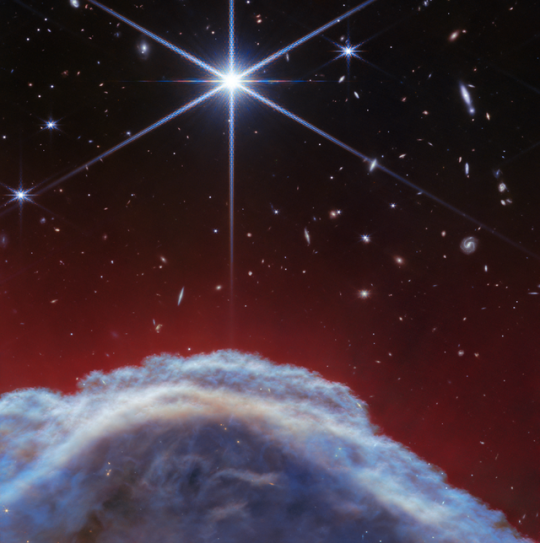
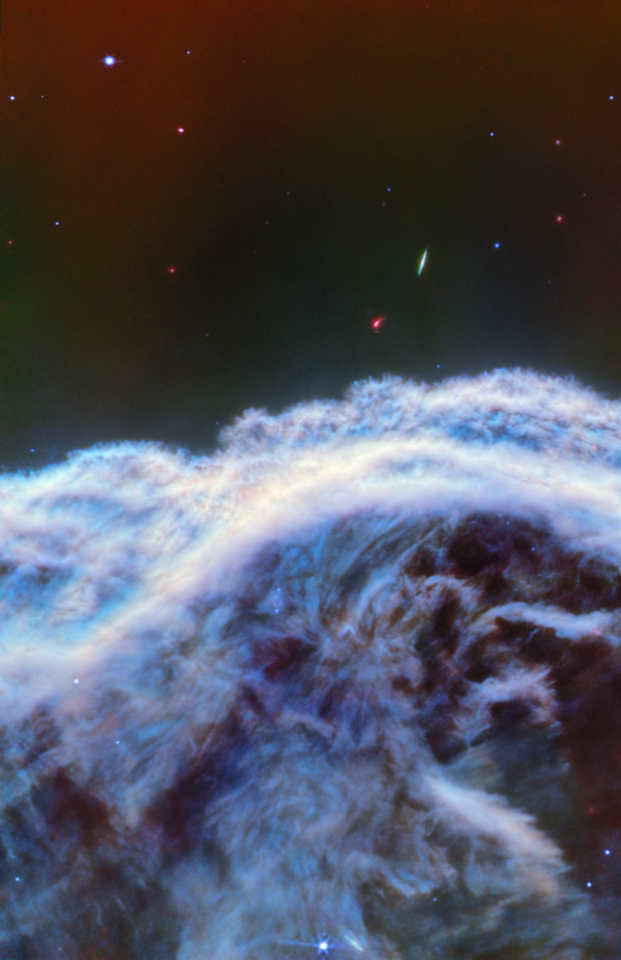
This image of the Horsehead Nebula from NASA’s James Webb Space Telescope focuses on a portion of the horse’s “mane” that is about 0.8 light-years in width. It was taken with Webb’s NIRCam (Near-infrared Camera). The ethereal clouds that appear blue at the bottom of the image are dominated by cold, molecular hydrogen. Red-colored wisps extending above the main nebula represent mainly atomic hydrogen gas.
Credit: NASA
2K notes
·
View notes
Text

An image captured by the James Webb Space Telescope shows Herbig-Haro 49/50, or simply HH 49/50, a type of nebula associated with star formation. The Near-Infrared Camera (NIRCam) and Mid-Infrared Instrument (MIRI) instruments were used in combination to observe infrared details of the outflows whose shape led to the object being nicknamed the Cosmic Tornado. For years, astronomers have wondered what the object they could barely see in images obtained with other instruments at the "tip of the tornado" was, and Webb helped them realize that it's a spiral galaxy that is far more distant.
73 notes
·
View notes
Text
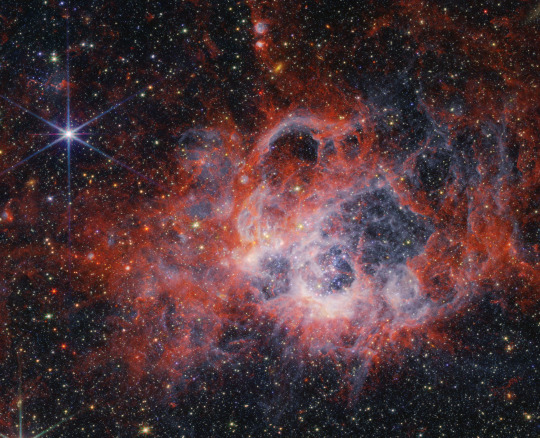
Looking Beyond the Veil This image from NASA’s James Webb Space Telescope’s NIRCam (Near-Infrared Camera) of star-forming region NGC 604 shows how stellar winds from bright, hot young stars carve out cavities in surrounding gas and dust.
299 notes
·
View notes
Text
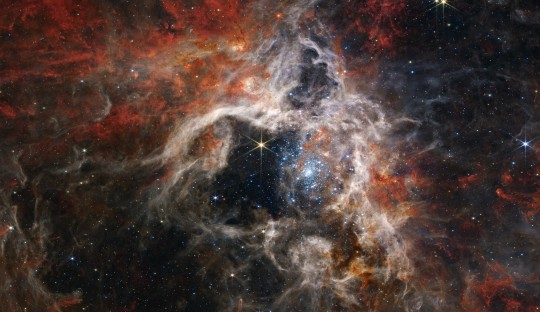
The Tarantula Nebula
A nursery of stars, caught in NASA's Webb.
In this mosaic image stretching 340 light-years across, Webb’s Near-Infrared Camera (NIRCam) displays the Tarantula Nebula star-forming region in a new light, including tens of thousands of never-before-seen young stars that were previously shrouded in cosmic dust. The most active region appears to sparkle with massive young stars, appearing pale blue.
#james webb space telescope#The Tarantula Nebula#NASA#nasa photos#nasa picture of the day#nasawebb#space#deep space#space telescope
158 notes
·
View notes
Text
Behold NGC 2283, a barred spiral galaxy 45 million light-years away captured by James Webb Telescope

The James Webb Space Telescope has done it again! Today, NASA/ESA/CSA released Webb’s latest mesmerizing image—a breathtaking view of the barred spiral galaxy NGC 2283, located 45 million light-years away in the constellation Canis Major. This cosmic marvel, captured using Webb’s Near-Infrared Camera (NIRCam) and Mid-Infrared Instrument (MIRI), showcases the galaxy’s intricate structure, star-forming regions, and the life cycle of stars in dazzling detail.
A Glimpse into the Heart of NGC 2283
Barred spiral galaxies like NGC 2283 have a central bar of stars, acting as a cosmic highway that channels gas into the galaxy’s core, fueling star formation. Webb’s infrared eyes reveal the delicate interplay between stars, gas, and dust, bringing into focus the glowing knots of gas where new stars are being born. These dense pockets of hydrogen, ignited by stellar nurseries, illuminate the graceful spiral arms winding around the core.
The Power of Infrared Imaging
Webb observed NGC 2283 for 17 minutes, collecting data across six different infrared filters. These filters allow astronomers to peer through cosmic dust and uncover hidden details. The image reveals:
Brilliant star clusters scattered throughout the spiral arms
Polycyclic aromatic hydrocarbons (PAHs), sooty molecules that help astronomers trace cosmic chemistry
Interstellar gas clouds heated by young, massive stars
Foreground stars from our Milky Way, their diffraction spikes adding to the celestial display
A Galaxy Shaped by Stellar Explosions
NGC 2283 is no stranger to cosmic fireworks. Just over two years ago, astronomers witnessed a stellar explosion in this very galaxy. The supernova, SN 2023AXU, was a Type II supernova—the violent death of a massive star at least eight times the mass of our Sun. These spectacular explosions enrich the galaxy with elements like oxygen and sodium, seeding the next generation of stars and continuing the grand cosmic cycle.
Part of a Larger Cosmic Survey
This image is part of an ambitious Webb program (#3707) aimed at studying the intricate relationships between stars, gas, and dust in 55 nearby star-forming galaxies. By observing these galactic ecosystems, astronomers hope to unravel the mysteries of star formation and galaxy evolution, giving us deeper insights into our own Milky Way’s origins.
A Cosmic Time Machine
As we marvel at this new glimpse of NGC 2283, we are reminded that every light-year Webb’s gaze traverses is a journey back in time. This image captures NGC 2283 as it was 45 million years ago—when early primates roamed Earth and our planet was undergoing climatic shifts. Through Webb’s lens, we witness history written in the language of starlight.
Stay tuned for more stunning discoveries as Webb continues to unlock the universe’s deepest secrets. What do you see in this cosmic portrait? Share your thoughts in the comments! Visit www.jameswebbdiscovery.com for the latest discoveries.
#nasa#james webb space telescope#jwst#webb discoveries#spaceexploration#jameswebbtelescope#astronomy#stargazing
30 notes
·
View notes
Photo
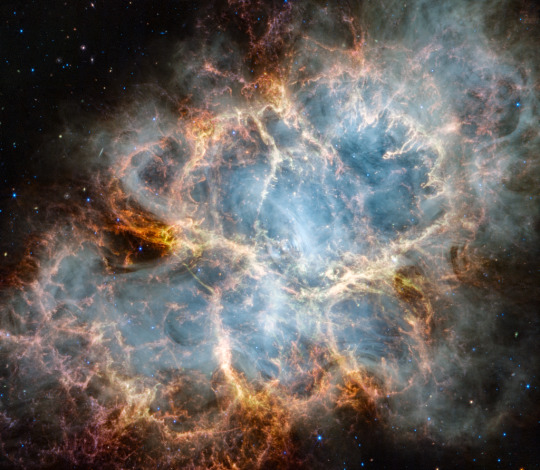
2023 November 9
M1: The Crab Nebula Image Credit: NASA, ESA, CSA, STScI; Tea Temim (Princeton University)
Explanation: The Crab Nebula is cataloged as M1, the first object on Charles Messier's famous 18th century list of things which are not comets. In fact, the Crab is now known to be a supernova remnant, debris from the death explosion of a massive star witnessed by astronomers in the year 1054. This sharp image from the James Webb Space Telescope’s NIRCam (Near-Infrared Camera) and MIRI (Mid-Infrared Instrument) explores the eerie glow and fragmented strands of the still expanding cloud of interstellar debris in infrared light. One of the most exotic objects known to modern astronomers, the Crab Pulsar, a neutron star spinning 30 times a second, is visible as a bright spot near the nebula's center. Like a cosmic dynamo, this collapsed remnant of the stellar core powers the Crab's emission across the electromagnetic spectrum. Spanning about 12 light-years, the Crab Nebula is a mere 6,500 light-years away in the head-strong constellation Taurus.
∞ Source: apod.nasa.gov/apod/ap231109.html
200 notes
·
View notes
Text
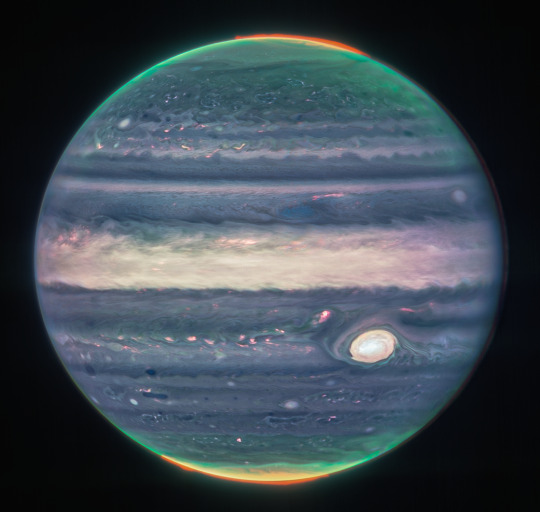
Jupiter in ultraviolet
Auroras and hazes glow in this composite image of Jupiter taken by the James Webb Space Telescope’s Near-Infrared Camera (NIRCam). NIRCam has three specialized infrared filters that showcase details of the planet.
#astronomy#astrophotography#astro community#science#photography#cosmos#solar system#space#jupiter#james webb space telescope#nasa#nasa photos#nasa jpl
107 notes
·
View notes
Text
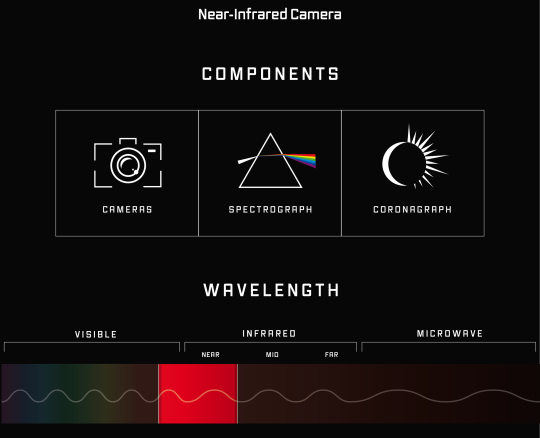
Many of the gorgeous space images that you see from the James Webb Space Telescope come from the Near-Infrared Camera (NIRCam). It provides high-resolution imaging and spectroscopy for a wide variety of scientific investigations. What can NIRCam “see” in space? https://webbtelescope.pub/4dEjG67
#space#astronomy#stsci#science#nasa#universe#nasawebb#james webb space telescope#webb#webb telescope#webb space telescope#nircam
33 notes
·
View notes
Text

This image by NASA’s James Webb Space Telescope’s NIRCam (Near-Infrared Camera) and MIRI (Mid-Infrared Instrument) shows different structural details of the Crab Nebula. The observations were taken as part of General Observer program 1714.
(NASA, ESA, CSA, STScI, Tea Temim/Princeton University)
#tea temim#photographer#princeton university#nasa#eas#james webb space telescope nircam#miri (mid-infrared instrument)#crab nebula#astronomy#nature#space#nebula
13 notes
·
View notes
Text
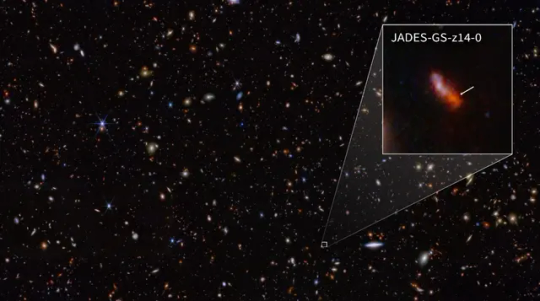
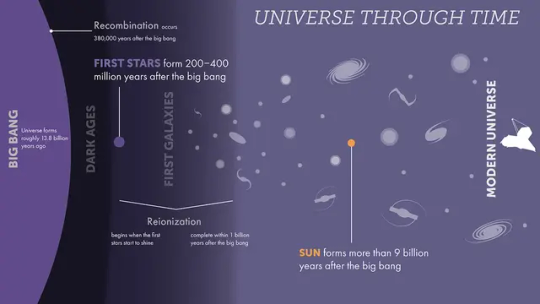
Unexpected complex chemistry in primordial galaxy
University of Arizona astronomers have learned more about a surprisingly mature galaxy that existed when the universe was just less than 300 million years old – just 2% of its current age.
Observed by NASA's James Webb Space Telescope, the galaxy – designated JADES-GS-z14-0 – is unexpectedly bright and chemically complex for an object from this primordial era, the researchers said. This provides a rare glimpse into the universe's earliest chapter.
The findings, published in the journal Nature Astronomy, build upon the researchers' previous discovery, reported in 2024, of JADES-GS-z14-0 as the most distant galaxy ever observed. While the initial discovery established the galaxy's record-breaking distance and unexpected brightness, this new research delves deeper into its chemical composition and evolutionary state.
The work was done as part of the JWST Advanced Deep Extragalactic Survey, or JADES, a major James Webb Space Telescope program designed to study distant galaxies.
This wasn't simply stumbling upon something unexpected, said Kevin Hainline, co-author of the new study and an associate research professor at the U of A Steward Observatory. The survey was deliberately designed to find distant galaxies, but this one broke the team's records in ways they didn't anticipate – it was intrinsically bright and had a complex chemical composition that was totally unexpected so early in the universe's history.
"It's not just a tiny little nugget. It's bright and fairly extended for the age of the universe when we observed it," Hainline said.
"The fact that we found this galaxy in a tiny region of the sky means that there should be more of these out there," said lead study author Jakob Helton, a graduate researcher at Steward Observatory. "If we looked at the whole sky, which we can't do with JWST, we would eventually find more of these extreme objects."
The research team used multiple instruments on board JWST, including the Near Infrared Camera, or NIRCam, whose construction was led by U of A Regents Professor of Astronomy Marcia Rieke. Another instrument on the telescope – the Mid-Infrared Instrument, or MIRI, revealed something extraordinary: significant amounts of oxygen.
In astronomy, anything heavier than helium is considered a "metal," Helton said. Such metals require generations of stars to produce. The early universe contained only hydrogen, helium and trace amounts of lithium. But the discovery of substantial oxygen in the JADES-GS-z14-0 galaxy suggests the galaxy had been forming stars for potentially 100 million years before it was observed.
To make oxygen, the galaxy must have started out very early on, because it would have had to form a generation of stars, said George Rieke, Regents Professor of Astronomy and the study's senior author. Those stars must have evolved and exploded as supernovae to release oxygen into interstellar space, from which new stars would form and evolve.
"It's a very complicated cycle to get as much oxygen as this galaxy has. So, it is genuinely mind boggling," Rieke said.
The finding suggests that star formation began even earlier than scientists previously thought, which pushes back the timeline for when the first galaxies could have formed after the Big Bang.
The observation required approximately nine days of telescope time, including 167 hours of NIRCam imaging and 43 hours of MIRI imaging, focused on an incredibly small portion of the sky.
The U of A astronomers were lucky that this galaxy happened to sit in the perfect spot for them to observe with MIRI. If they had pointed the telescope just a fraction of a degree in any direction, they would have missed getting this crucial mid-infrared data, Helton said.
"Imagine a grain of sand at the end of your arm. You see how large it is on the sky – that's how large we looked at," Helton said.
The existence of such a developed galaxy so early in cosmic history serves as a powerful test case for theoretical models of galaxy formation.
"Our involvement here is a product of the U of A leading in infrared astronomy since the mid-'60s, when it first started. We had the first major infrared astronomy group over in the Lunar and Planetary lab, with Gerard Kuiper, Frank Low and Harold Johnson," Rieke said.
As humans gain the ability to directly observe and understand galaxies that existed during the universe's infancy, it can provide crucial insights into how the universe evolved from simple elements to the complex chemistry necessary for life as we know it.
"We're in an incredible time in astronomy history," Hainline said. "We're able to understand galaxies that are well beyond anything humans have ever found and see them in many different ways and really understand them. That's really magic."
TOP IMAGE: This infrared image from NASA’s James Webb Space Telescope was taken by the onboard Near-Infrared Camera for the JWST Advanced Deep Extragalactic Survey, or JADES, program. The NIRCam data was used to determine which galaxies to study further with spectroscopic observations. One such galaxy, JADES-GS-z14-0 (shown in the pullout), was determined to be at a redshift of 14.3, making it the current record-holder for most distant known galaxy. This corresponds to a time less than 300 million years after the big bang. NASA, ESA, CSA, STScI, Brant Robertson (UC Santa Cruz), Ben Johnson (CfA), Sandro Tacchella (Cambridge), Marcia Rieke (University of Arizona), Daniel Eisenstein (CfA), Phill Cargile (CfA)
LOWER IMAGE: Timeline of the universe: Although we are not sure exactly when the first stars began to shine, we know that they must have formed sometime after the era of Recombination, when hydrogen and helium atoms formed (380,000 years after the big bang), and before the oldest-known galaxies existed (400 million years after the big bang). The ultraviolet light emitted by the first stars broke down the neutral hydrogen gas filling the universe into hydrogen ions and free electrons, initiating the era of Reionization and the end of the Dark Ages of the universe. NASA, ESA, CSA, STScI
11 notes
·
View notes
Text
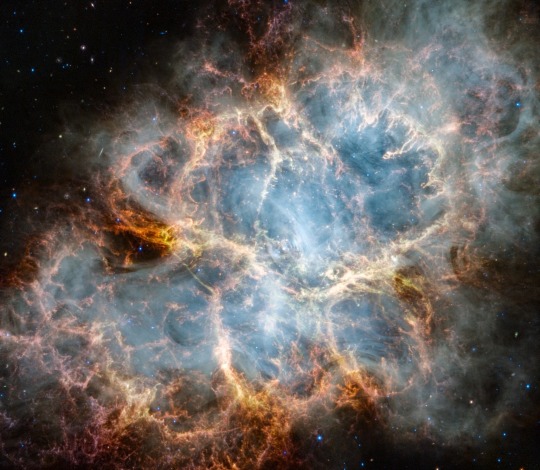
Crab Nebula, taken by the James Webb Space Telescope’s NIRCam (Near-Infrared Camera) & MIRI (Mid-Infrared Instrument)
Published by NASA 10/30/23
#photography#space#telescope#james webb space telescope#nebula#crab nebula#universe#stars#infrared#astronomy#galaxies#discovery#science#nasa
102 notes
·
View notes
Text
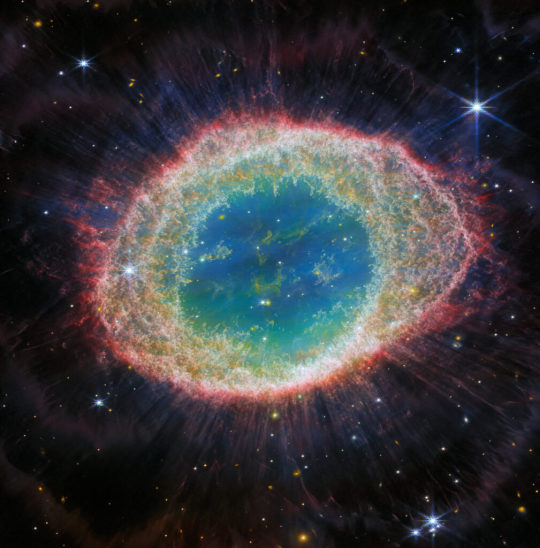
NASA’s James Webb Space Telescope has observed the well-known Ring Nebula in unprecedented detail. Formed by a star throwing off its outer layers as it runs out of fuel, the Ring Nebula is an archetypal planetary nebula. This new image from Webb’s NIRCam (Near-Infrared Camera) shows intricate details of the filament structure of the inner ring. There are some 20,000 dense globules in the nebula, which are rich in molecular hydrogen. In contrast, the inner region shows very hot gas. The main shell contains a thin ring of enhanced emission from carbon-based molecules known as polycyclic aromatic hydrocarbons (PAHs).
Credit: ESA/Webb, NASA, CSA, M. Barlow (University College London), N. Cox (ACRI-ST), R. Wesson (Cardiff University)
2K notes
·
View notes
Text
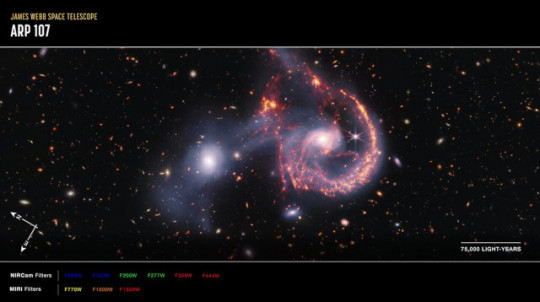
An image captured by the James Webb Space Telescope shows Arp 107, a pair of interacting galaxies. The spiral galaxy UGC 5984 (or PGC 32620) and the elliptical galaxy MCG +05-26-025 (or PGC 32628) will eventually merge. The Arp 107 pair was already studied several times with various telescopes but the combination of the MIRI (Mid-Infrared Instrument) and NIRCam (Near-Infrared Camera) instruments allowed to capture many new details of the star formation activity triggered by the interaction between the two galaxies.
17 notes
·
View notes